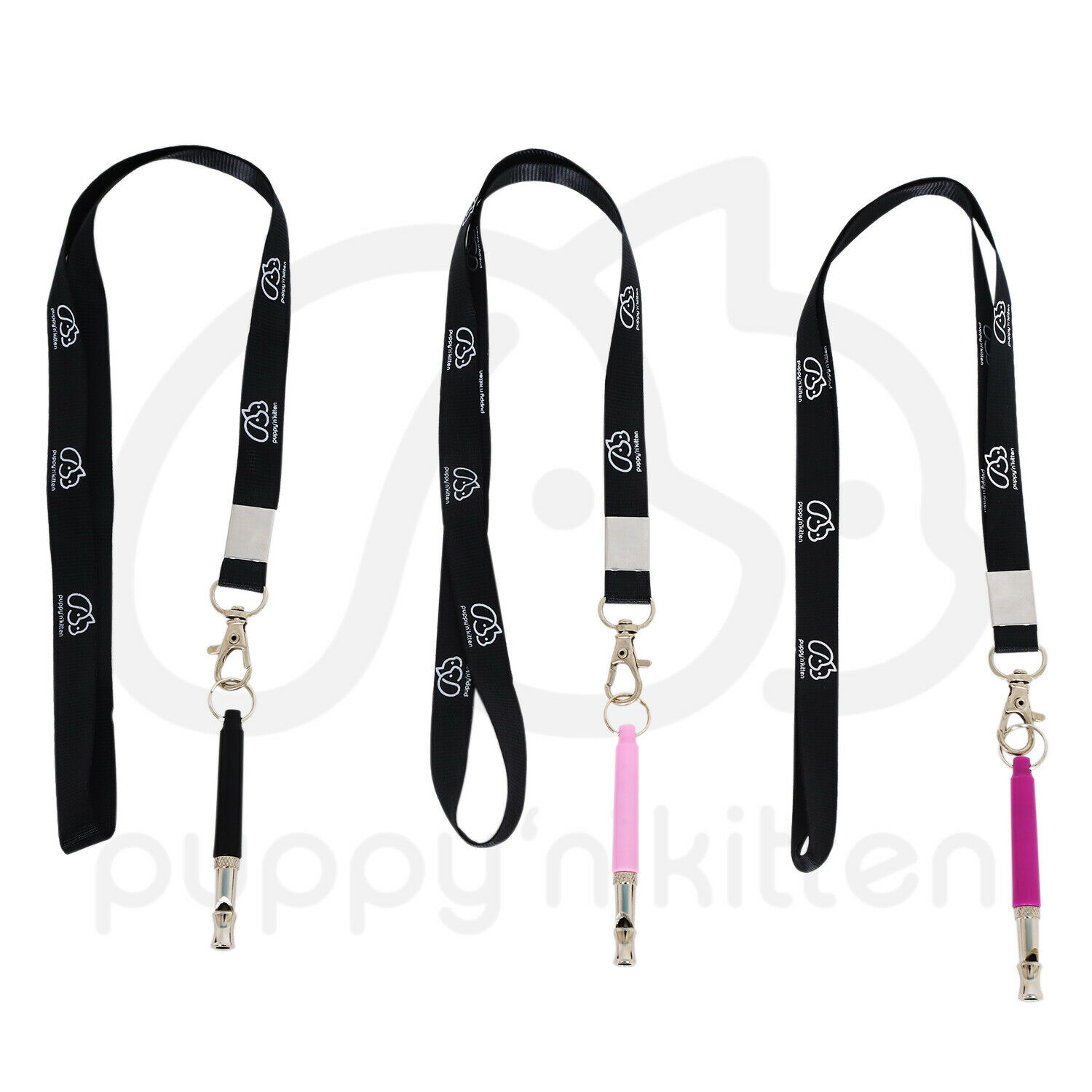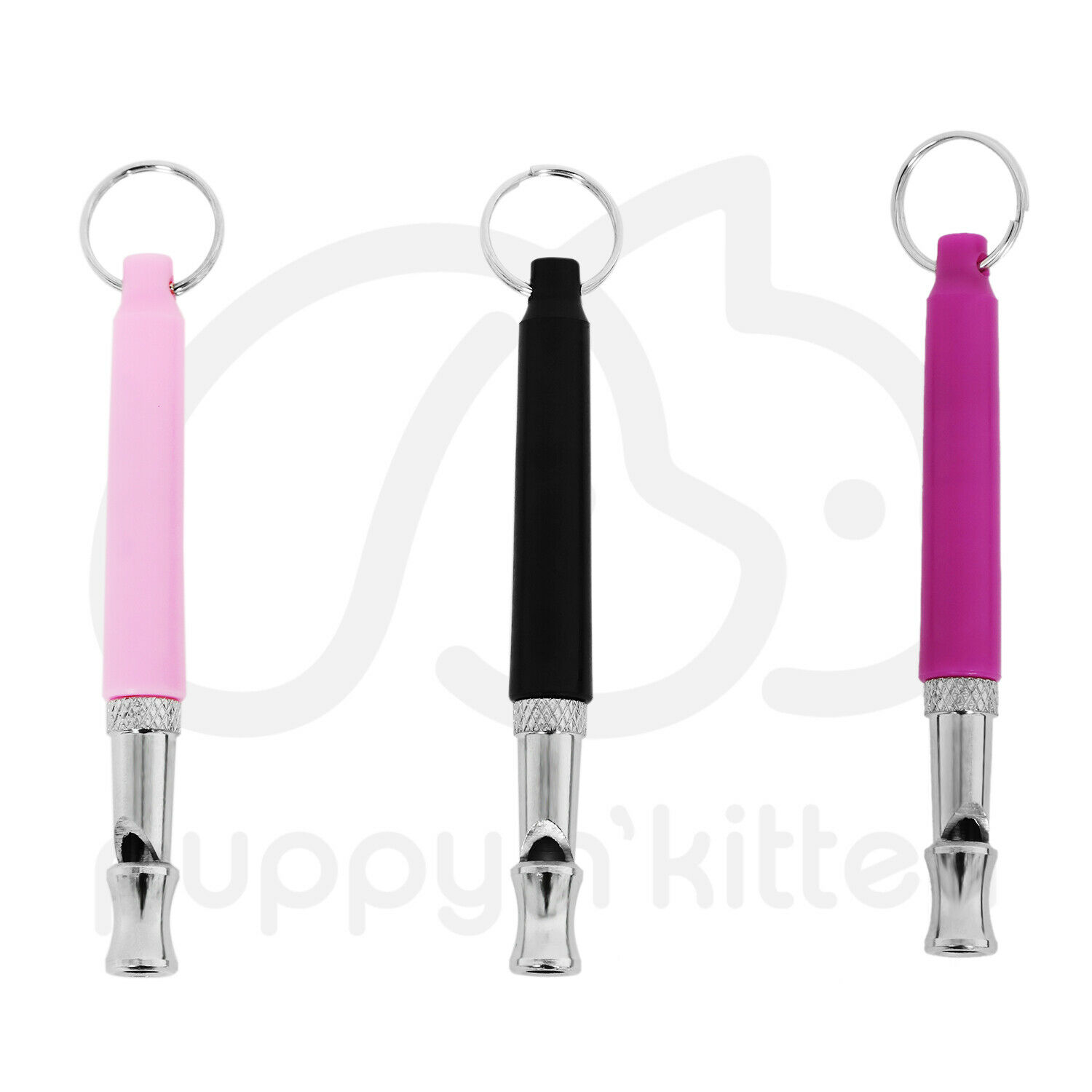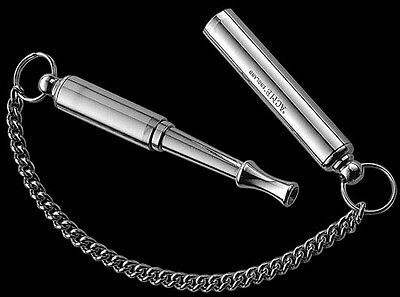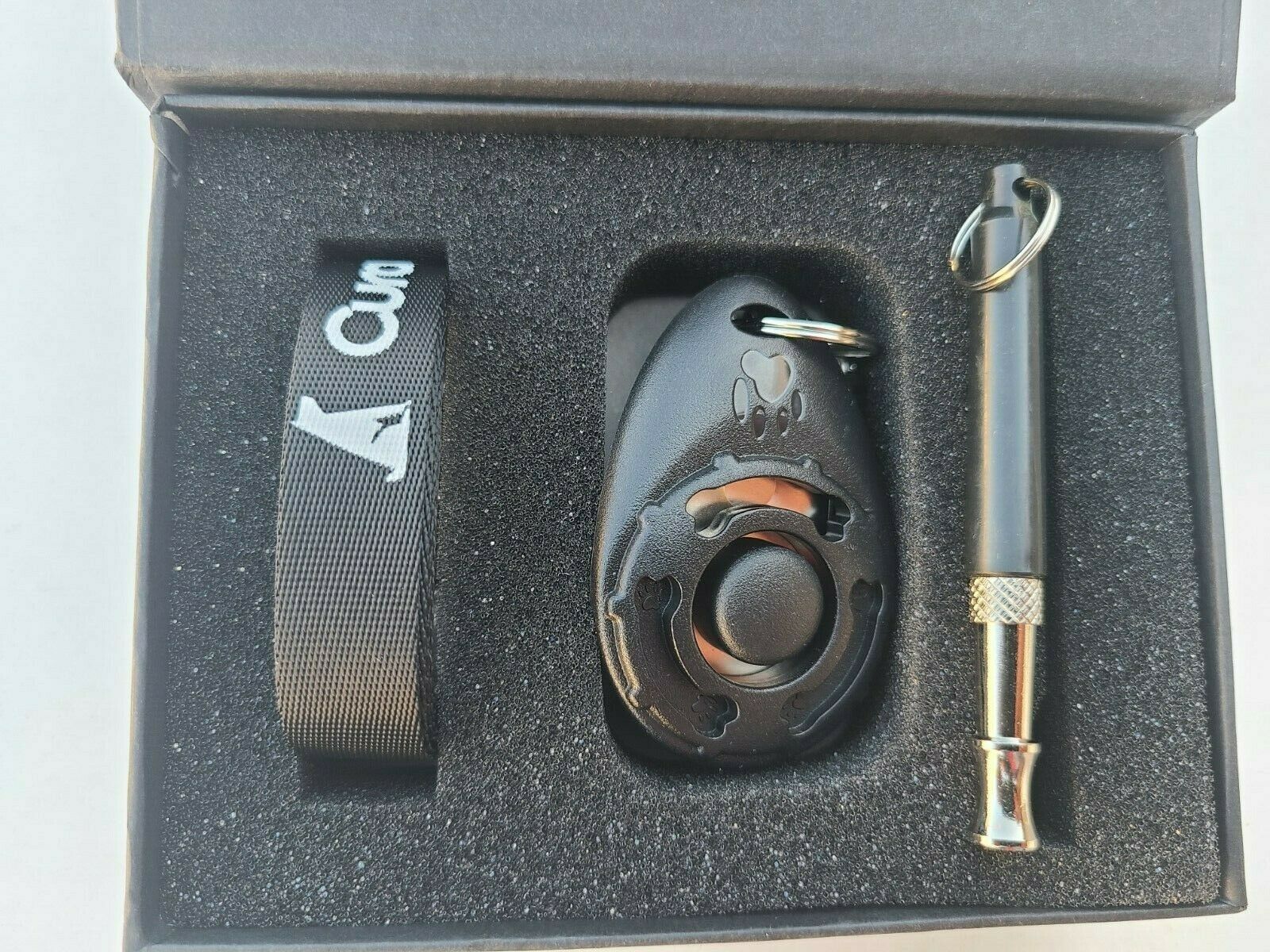-40%
2 PCS Dog Training Whistle Super Sonic Obedience Stop Barking Pet Sound Pitch
$ 3.69
- Description
- Size Guide
Description
Horizon Digital ScalesP R E C I S I O N S C A L E S & M O R E
Buy one
Get one 12% OFF
Fast Shipping
2 PCS Dog Training Whistle Super Sonic Obedience Stop Barking Pet Sound Pitch
PRECISION SCALES
Quality Assured
Buy from the Expert
Features
This Dog Training Whistle is designed for dog training
A plastic sleeve protects the adjustment area
Great for recall over long distances
Key ring loop included
Specifications
Material: Metal & Plastic
Color: Black, Pink, or Purple (pick your color)
Items Includes
Two (2) Dog Whistles (pick your color)
Two (2) Key ring loops
PLEASE BE AWARE OF THIS FACT THEY ARE NOT TOTALLY SILENT.
Speak Before You Whistle
If your dog hasn't been trained to respond to your voice commands, he won't be able to respond to a whistle since there's nothing to associate the whistle with. He'll need to learn the recall command of "here" or "come" as well as "sit." When your dog has mastered those two actions at your prompting, you're ready to add a whistle into the mix.
Unique Signals
Each command should have a distinct whistle prompt. For example, "sit" may be two quick blasts while "here" is one drawn out whistle. The key is to choose signals that aren't easily confused and apply them consistently over the course of training.
Whistling to Sit
Start with the "sit" command and get your dog to sit properly from a verbal command or hand signal. The next "sit" should be accompanied by the whistle, followed by great praise, and perhaps a treat, for doing as instructed. Repeat several times before attempting to direct him with the whistle. If he responds properly, praise and reward him and if not, give him the verbal command, followed by the whistle. When he responds to the whistle prompt, begin transitioning to the whistle by alternating between a verbal command with the whistle and the whistle only. After he understands the whistle command for "sit," gradually increase your distance from him over multiple training sessions until he'll sit to a whistle command as far as 50 yards away. Beyond that point, you'll be able to train him to sit when he can't see you but can hear your whistle.
Whistling to Recall
A whistle is especially helpful to call your dog over great distances. Whenever your dog responds properly to a "here" command, it should be like a party -- even if he's been misbehaving. Punishing a dog who comes when called will make him avoid you. As with the "sit" command, practice adding your chosen whistle signal to the "here" command, starting from several feet away. As he begins to make the association of "here" and your signal, gradually increase the distance between you. When you work on this command, make sure you always start with a "sit." Since you need to reinforce "sit" as well, you'll want to mix it up a bit. Sometimes you'll whistle a sit and walk away to leave him sit, while other times you'll walk away and give him the corresponding signal to come. Your dog needs to learn that "sit" isn't always followed by a "here" command.
This dog whistle can be load to human's you must work with your dog to train it to do want you want the dog to do I have given instruction on this Please read your dog may need to get use to the whistle before the dog will react to it .
Payment
Shipping
We accept
PayPal
Please pay as soon as possible after winning an auction, allowing us to ship your order to you sooner!
We offer
FREE shipping
on most orders.
Your order will be shipped generally within one working day including saturdays. We will try to process your order in the same day if payment is received before noon (US Eastern Time).
About Us
We have been manufacturing and distributing precision scales and calibration weights since 2009. We professionally calibrate and test all scales that we ship.
If you are not 100% satisfied with your order, you can return the product and get a full refund or replacement (your choice). The return process is eBay managed and hassle free.
Returns
Quality Products
Fast Shipping
Best Prices
Features ---This Dog Training Whistle is designed for dog training ---A plastic sleeve protects the adjustment area ---Great for recall over long distances ---Key ring loop included Specifications ---Material: Metal & Plastic ---Color: Black, Pink, or Purple (pick your color) Items Includes ---Two (2) Dog Whistles (pick your color) ---Two (2) Key ring loops PLEASE BE AWARE OF THIS FACT THEY ARE NOT TOTALLY SILENT. Speak Before You Whistle If your dog hasn't been trained to respond to your voice commands, he won't be able to respond to a whistle since there's nothing to associate the whistle with. He'll need to learn the recall command of "here" or "come" as well as "sit." When your dog has mastered those two actions at your prompting, you're ready to add a whistle into the mix. Unique Signals Each command should have a distinct whistle prompt. For example, "sit" may be two quick blasts while "here" is one drawn out whistle. The key is to choose signals that aren't easily confused and apply them consistently over the course of training. Whistling to Sit Start with the "sit" command and get your dog to sit properly from a verbal command or hand signal. The next "sit" should be accompanied by the whistle, followed by great praise, and perhaps a treat, for doing as instructed. Repeat several times before attempting to direct him with the whistle. If he responds properly, praise and reward him and if not, give him the verbal command, followed by the whistle. When he responds to the whistle prompt, begin transitioning to the whistle by alternating between a verbal command with the whistle and the whistle only. After he understands the whistle command for "sit," gradually increase your distance from him over multiple training sessions until he'll sit to a whistle command as far as 50 yards away. Beyond that point, you'll be able to train him to sit when he can't see you but can hear your whistle. Whistling to Recall A whistle is especially helpful to call your dog over great distances. Whenever your dog responds properly to a "here" command, it should be like a party -- even if he's been misbehaving. Punishing a dog who comes when called will make him avoid you. As with the "sit" command, practice adding your chosen whistle signal to the "here" command, starting from several feet away. As he begins to make the association of "here" and your signal, gradually increase the distance between you. When you work on this command, make sure you always start with a "sit." Since you need to reinforce "sit" as well, you'll want to mix it up a bit. Sometimes you'll whistle a sit and walk away to leave him sit, while other times you'll walk away and give him the corresponding signal to come. Your dog needs to learn that "sit" isn't always followed by a "here" command. This dog whistle can be load to human's you must work with your dog to train it to do want you want the dog to do I have given instruction on this Please read your dog may need to get use to the whistle before the dog will react to it .
2 PCS Dog Training Whistle Super Sonic Obedience Stop Barking Pet Sound Pitch
Features
This Dog Training Whistle is designed for dog training
A plastic sleeve protects the adjustment area
Great for recall over long distances
Key ring loop included
Specifications
Material: Metal & Plastic
Color: Black, Pink, or Purple (pick your color)
Items Includes
Two (2) Dog Whistles (pick your color)
Two (2) Key ring loops
PLEASE BE AWARE OF THIS FACT THEY ARE NOT TOTALLY SILENT.
Speak Before You Whistle
If your dog hasn't been trained to respond to your voice commands, he won't be able to respond to a whistle since there's nothing to associate the whistle with. He'll need to learn the recall command of "here" or "come" as well as "sit." When your dog has mastered those two actions at your prompting, you're ready to add a whistle into the mix.
Unique Signals
Each command should have a distinct whistle prompt. For example, "sit" may be two quick blasts while "here" is one drawn out whistle. The key is to choose signals that aren't easily confused and apply them consistently over the course of training.
Whistling to Sit
Start with the "sit" command and get your dog to sit properly from a verbal command or hand signal. The next "sit" should be accompanied by the whistle, followed by great praise, and perhaps a treat, for doing as instructed. Repeat several times before attempting to direct him with the whistle. If he responds properly, praise and reward him and if not, give him the verbal command, followed by the whistle. When he responds to the whistle prompt, begin transitioning to the whistle by alternating between a verbal command with the whistle and the whistle only. After he understands the whistle command for "sit," gradually increase your distance from him over multiple training sessions until he'll sit to a whistle command as far as 50 yards away. Beyond that point, you'll be able to train him to sit when he can't see you but can hear your whistle.
Whistling to Recall
A whistle is especially helpful to call your dog over great distances. Whenever your dog responds properly to a "here" command, it should be like a party -- even if he's been misbehaving. Punishing a dog who comes when called will make him avoid you. As with the "sit" command, practice adding your chosen whistle signal to the "here" command, starting from several feet away. As he begins to make the association of "here" and your signal, gradually increase the distance between you. When you work on this command, make sure you always start with a "sit." Since you need to reinforce "sit" as well, you'll want to mix it up a bit. Sometimes you'll whistle a sit and walk away to leave him sit, while other times you'll walk away and give him the corresponding signal to come. Your dog needs to learn that "sit" isn't always followed by a "here" command.
This dog whistle can be load to human's you must work with your dog to train it to do want you want the dog to do I have given instruction on this Please read your dog may need to get use to the whistle before the dog will react to it .
Payment
We accept
PayPal
Please pay as soon as possible after winning an auction, allowing us to ship your order to you sooner!
Shipping
We offer
FREE shipping
on most orders.
Your order will be shipped generally within one working day including saturdays. We will try to process your order in the same day if payment is received before noon (US Eastern Time).
About Us
We have been manufacturing and distributing precision scales and calibration weights since 2009. We professionally calibrate and test all scales that we ship.
Returns
If you are not 100% satisfied with your order, you can return the product and get a full refund or replacement (your choice). The return process is eBay managed and hassle free.
Features
This Dog Training Whistle is designed for dog training
A plastic sleeve protects the adjustment area
Great for recall over long distances
Key ring loop included
Specifications
Material: Metal & Plastic
Color: Black, Pink, or Purple (pick your color)
Items Includes
Two (2) Dog Whistles (pick your color)
Two (2) Key ring loops
PLEASE BE AWARE OF THIS FACT THEY ARE NOT TOTALLY SILENT.
Speak Before You Whistle
If your dog hasn't been trained to respond to your voice commands, he won't be able to respond to a whistle since there's nothing to associate the whistle with. He'll need to learn the recall command of "here" or "come" as well as "sit." When your dog has mastered those two actions at your prompting, you're ready to add a whistle into the mix.
Unique Signals
Each command should have a distinct whistle prompt. For example, "sit" may be two quick blasts while "here" is one drawn out whistle. The key is to choose signals that aren't easily confused and apply them consistently over the course of training.
Whistling to Sit
Start with the "sit" command and get your dog to sit properly from a verbal command or hand signal. The next "sit" should be accompanied by the whistle, followed by great praise, and perhaps a treat, for doing as instructed. Repeat several times before attempting to direct him with the whistle. If he responds properly, praise and reward him and if not, give him the verbal command, followed by the whistle. When he responds to the whistle prompt, begin transitioning to the whistle by alternating between a verbal command with the whistle and the whistle only. After he understands the whistle command for "sit," gradually increase your distance from him over multiple training sessions until he'll sit to a whistle command as far as 50 yards away. Beyond that point, you'll be able to train him to sit when he can't see you but can hear your whistle.
Whistling to Recall
A whistle is especially helpful to call your dog over great distances. Whenever your dog responds properly to a "here" command, it should be like a party -- even if he's been misbehaving. Punishing a dog who comes when called will make him avoid you. As with the "sit" command, practice adding your chosen whistle signal to the "here" command, starting from several feet away. As he begins to make the association of "here" and your signal, gradually increase the distance between you. When you work on this command, make sure you always start with a "sit." Since you need to reinforce "sit" as well, you'll want to mix it up a bit. Sometimes you'll whistle a sit and walk away to leave him sit, while other times you'll walk away and give him the corresponding signal to come. Your dog needs to learn that "sit" isn't always followed by a "here" command.
This dog whistle can be load to human's you must work with your dog to train it to do want you want the dog to do I have given instruction on this Please read your dog may need to get use to the whistle before the dog will react to it .

















